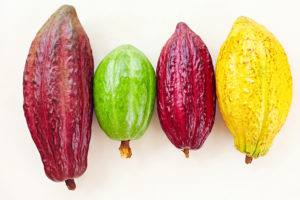The bean and the tree

Cocoa products come from cocoa beans, found inside the fruit of the cocoa tree. These fruits grow directly on the trunk and thick branches. Wild cocoa trees can reach 15 meters, but cultivated ones are pruned to 4-5 meters for easier harvesting. Cocoa trees can flower year-round, depending on the climate, but only 20-40 flowers develop into fruit, each about 20 cm long and 10 cm wide.
Each fruit contains around 40 seeds, the cocoa beans, weighing about 1-2 grammes each. During harvesting, the beans are collected with the fruit pulp, which ferments, generating heat and leading to the creation of the beans’ distinct aroma while turning them dark brown. After fermentation, the beans are sun-dried then packed into sacks for shipping.
Cultivation
Cocoa trees grow exclusively under specific climate and soil conditions, and are vulnerable to drought, temperature extremes, diseases and pests. The cocoa belt currently spans between 20 degrees (latitude) North and South of the Equator, with most cocoa growing within 10 degrees from the Equator. In addition, the soil has to be fairly loose and the climate humid. Temperatures are generally between 18 and 30 degrees Celsius, with precipitation fairly constant and minimally 1,000 mm per annum. Cocoa trees must not receive too much sun, nor too much shade. While cultivation is possible up to about 1,000 metres above sea level, most cocoa is grown below 300 metres.

Wild trees are mostly found in the Amazonian region, and archeological evidence suggests that cocoa has been appreciated by humans for over 5,000 years, resulting in the expansion of cultivation through other areas of South America and Mesoamerica. As the demand for cocoa in Europe grew in the sixteenth century (see below), plantations were also established in the Caribbean, the Indonesian archipelago and West Africa, which now accounts for more than half of the yearly world crop. Production has also markedly increased in Southeast Asia in recent years. For an overview of the distribution of cocoa production, please refer to the quarterly production statistics published by ICCO.
The trade has traditionally considered there to be three main cocoa types, each with its own chemical and physical properties: Criollo, Forastero, and Trinitario. Criollo has a fine aroma, Forastero is the term used for mainstream cocoas, while Trinitario is used to describe various hybrid types known for their floral/fruity flavours. Moreover, like coffee, cocoa is far from uniform as a raw material. Manufacturers blend various types of cocoa beans so as to guarantee products of a consistent high quality.
Taste and colour
Taste and colour of cocoa and its products are determined by multiple factors. Early in the production process, type of bean, growing conditions and post-harvest processes account for different flavours, but later manufacturing processes can also strongly influence the final product. For example, the colour of cocoa powder may vary from light orange/yellow to dark, reddish brown.
Nutritional Content
The edible nibs of the cocoa bean contain about 55% of fat, which is important for chocolate’s characteristic melting properties, 25% of carbohydrates, and 12% of protein after roasting. Cocoa powder is rich in natural fiber (nearly 30%) and has a relatively low calorie count (200–300 kcal per 100 grammes, depending on fat content. In addition, some cocoas have been shown to contain flavanols with anti-oxidant effects, which can bring health benefits.
History
Cocoa has a rich history spanning over 5,000 years. When the Spanish invaded Mesoamerica, they encountered the Mayan and Aztec cultures’ use of cocoa to make “xocolatl,” a spiced drink. Columbus introduced cocoa to Europe on his fourth voyage, and Hernán Cortés brought the Aztec recipe to Spain in 1521. The Spaniards sweetened the bitter drink with sugar or honey, transforming it into a luxurious treat. Initially limited to the Spanish elites, cocoa spread to European royal courts and eventually to the public by the 17th century. By then, Dutch merchants dominated the global cocoa trade, and Linnaeus named the cocoa tree Theobroma, meaning “food of the gods.”
The 19th century revolutionized cocoa production. In 1828, Dutchman Coenraad Johannes van Houten patented a method to press most of the fat from cocoa mass, creating cocoa powder and butter. He also introduced alkalization to improve flavour and colour. These innovations paved the way for Englishman John Fry, who developed solid chocolate in 1847, a smoother and richer alternative to cocoa drinks. Swiss chemist Henri Nestlé later invented milk chocolate in 1875, and the wrapped chocolate bar was another Dutch contribution. These advancements transformed cocoa into a global sensation, solidifying its role as a cherished ingredient in countless products.



